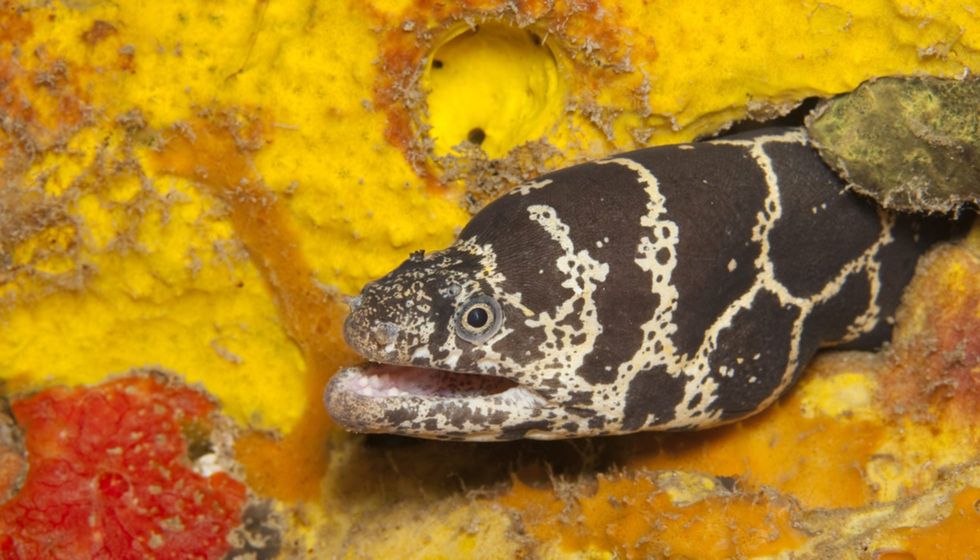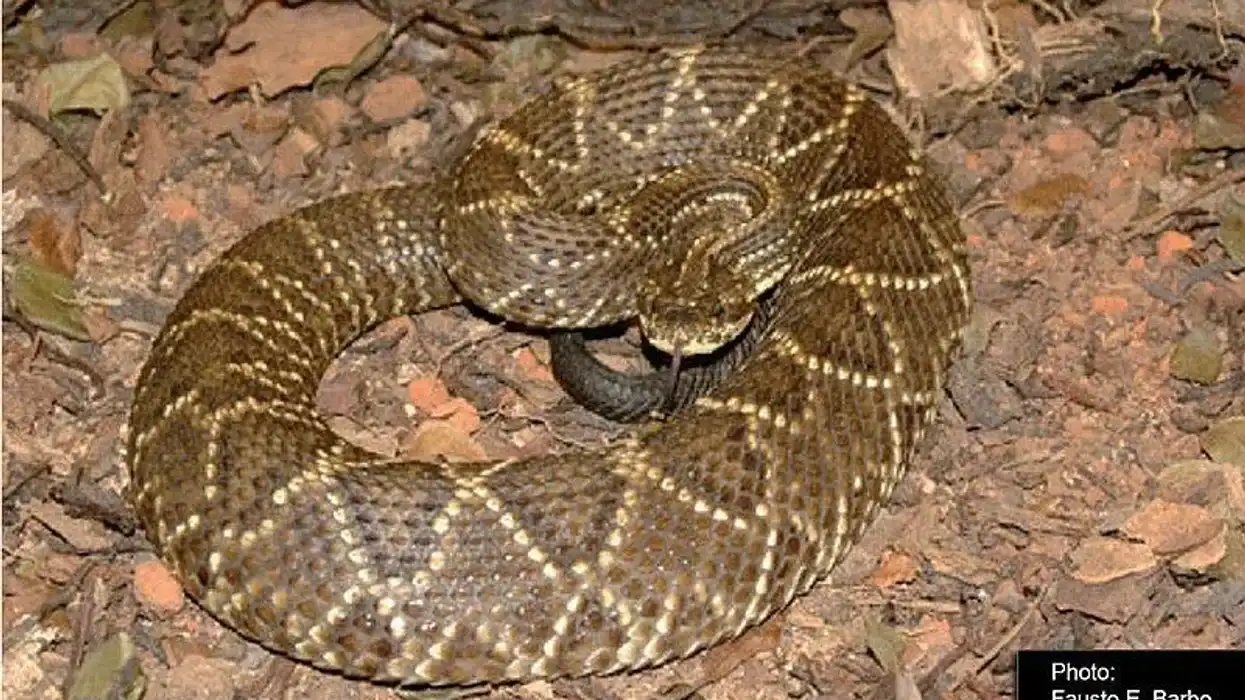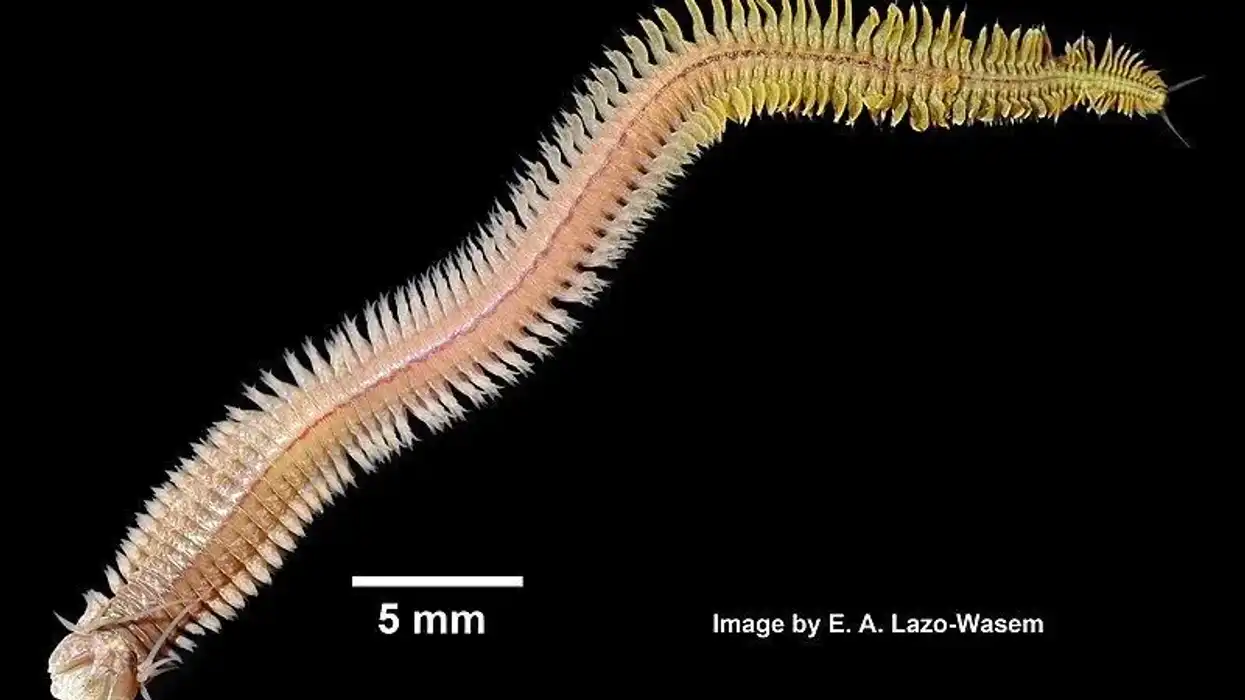The chain moray eel (Echidna catenata) is a moray eel species of the family Muraenidae found in the western Atlantic Ocean. This fish species has a dark brown to black body with an interlocking lattice-work of chain-like yellow lines.
Moray eels of the Echidna genus all lack canine teeth and mostly feed on crustaceans. As of 2017, 11 species have been recognized under the genus Echidnae by WoRMS and FishBase. Sometimes, the zebra moray (Gymnomutaena zebra) species is also included in this genus.
The Muraenidae family of moray eels are found throughout the world. There are 15 genera with almost 200 species.
The distribution of these species is across both saltwater and freshwater habitats. The originating point of the English term 'moray' is in the Greek 'muraina'. These 15 genera are divided into two subfamilies, Uropterygiinae and Muraeninae, which can be differentiated by the location of their fins.
There are 11 genera in the Muraeninae subfamily according to the World Register of Marine Species (WoRMS). Moray eels mostly depend on their sense of smell to hunt their food.
If you find these facts about chain moray eels interesting, you can read conger eel and ribbon eel facts on Kidadl.
Chain Moray Eel Interesting Facts
What type of animal is a chain moray eel?
Echidna catenata is a moray eel of the order Anguilliformes and phylum Chordata. This fish is nocturnal and hides in crevices and holes in the shallow water with the head projecting. The main diet of this fish is carnivorous.
Chain moray eels open and close their mouth continuously for increasing the flow of water over their gills. This fish remains in hiding places for the majority of the time, grabbing any prey that passes.
They display aggressive predation. They also search for food beneath rocks, in holes, and under the rims of pools. They are also profitable in the aquarium trade.
What class of animal does a chain moray eel belong to?
Moray eels (Echidna catenata) belong to the class of Actinopterygii of animals.
How many chain moray eels are there in the world?
The population size of this eel species has not been evaluated.
Where does a chain moray eel live?
The chain moray eel distribution is across the western Atlantic Ocean. The range of habitats extends from Florida, Bermuda, and the Bahamas through to Brazil and the Antilles.
They can be found commonly in the Caribbean and this fish species has also been reported around some southern Atlantic islands and in eastern Atlantic habitat ranges. This Atlantic species is native to almost all countries in the Caribbean.
What is a chain moray eel's habitat?
This fish species can be found in saltwater habitat ranges. They can be found at a depth of about 39 ft (12 m) and also within 6 ft (2 m) from the surface. They occupy coral reefs and rocky shores.
Who does the chain moray eel live with?
Moray eels are usually solitary and sometimes search for food in a group in their natural habitat.
How long does a chain moray eel live?
These eels can live up to 20 years.
How do they reproduce?
There is only a little information available on the spawning process of these eels. However, morays spawn in summer and spring. Some spawn once per year while others might several times a year. Observation showed that the males and females wrap around each other with an open mouth.
They pressed their abdomens together until they release gametes into the water column. The eggs measure up to 0.07-0.15 in (1.8-4 mm) in diameter. Leptocephalus (larvae) has large eyes, a small head, long and flat clear ribbon-like body.
What is their conservation status?
The conservation status of these eels is Not Evaluated. However, some data states that these marine species are listed as Least Concern.
Chain Moray Eel Fun Facts
What does the chain moray eel look like?
This Atlantic species has a dark brown to black body with an interlocking lattice-work of chain-like yellow lines. They are heavy and elongated eel-like fish.
They have pointed blunt teeth, particularly on the roof of the mouth and their head has rounded snout. Their teeth allow them to crush hard shells, especially crabs. The tail, anal, and dorsal fins are all conjoined to form a single long fin and they do not have ventral or pectoral fins.
Their skin is scaleless and is covered in clear mucus. Their eyes are yellow.
How cute are they?
These scaleless coral reef fish are not considered cute.
How do they communicate?
There is only a little bit known about communication in this species. They have a strong sense of smell which they use to locate spawning sites and food.
How big is a chain moray eel?
This chainlink moray eel size is 12-18 in (30-45 cm) in length. Electric eels are six times longer than these chain moray eels.
How fast can a chain moray eel swim?
Their smooth skin allows them to swim fast around coral reef without the fear of abrasion. The exact speed of chain moray eels is not known.
How much does a chain moray eel weigh?
The exact weight of chain moray eels is not known. However, moray eels can weigh up to 66 lb (30 kg). The European conger eel is the heaviest eel weighing up to 240 lb (110 kg).
What are the male and female names of the species?
There is no specific name given to the male and female species of this fish.
What would you call a baby chain moray eel?
There is no specific name given to the baby chain moray eel.
What do they eat?
The chain moray eel diet is carnivorous. When this fish is close to their prey, usually within 2-4 in (5-10 cm) they strike with their body partly or wholly out of water. They tear large crabs and small fish species are swallowed whole.
They can easily feed on crustaceans due to their teeth. They feed on crabs, shrimps, small fish species, and worms.
In captivity, make sure not to feed them any kind of freshwater fish, pellets, or flake. They can easily be trained to eat crustacean flesh. You can also feed them octopus flesh, live shrimp, squid flesh, whole blue crab, and gulf shrimp with shells.
Are they aggressive?
They are not usually aggressive. However, while trying to catch their prey they might seem aggressive as they ambush their prey.
Would they make a good pet?
They do make a good pet. The chainlink moray eel tank size must be 100 gal (379 l).
Did you know...
Eels are rarely infected by parasites. However, they do contract nematode worms which cause raised bumps under the skin.
Are chain moray eels reef safe?
All moray eels are reef safe. However, these eels might not be fish-safe. Some predators of morays are sea snakes, barracuda, groupers, and sharks.
Moray eels do bite but only when threatened. The bite wound can get nasty and deep. However, it is not life-threatening to humans.
How has the chain moray eel adapted to feeding on crabs in particular?
These eel species have blunt teeth, particularly on the roof of the mouth. They can easily tear shells of crab and shrimp.
Here at Kidadl, we have carefully created lots of interesting family-friendly animal facts for everyone to discover! For more relatable content, check out these tilefish facts and eel facts for kids.
You can even occupy yourself at home by coloring on one of our free printable fish coloring pages.









